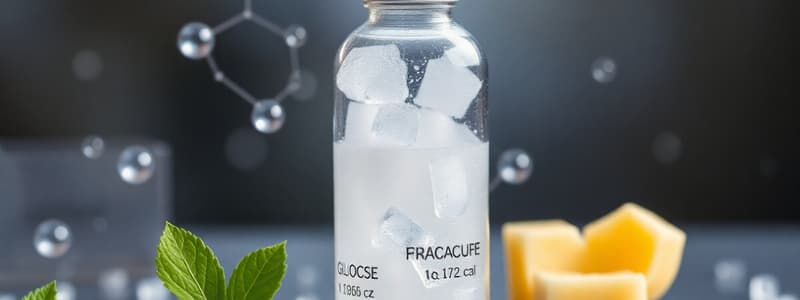Podcast
Questions and Answers
What are carbohydrates primarily used for in the body?
What are carbohydrates primarily used for in the body?
Energy sources
How are carbohydrates classified?
How are carbohydrates classified?
By their structure, such as polyhydroxy aldehydes or ketones
What do animals primarily derive their carbohydrates from?
What do animals primarily derive their carbohydrates from?
Plants
Brain cells and RBCs are almost wholly dependent on carbohydrates as the energy source.
Brain cells and RBCs are almost wholly dependent on carbohydrates as the energy source.
Which process do plants use to synthesize glucose?
Which process do plants use to synthesize glucose?
What are glycoproteins also known as?
What are glycoproteins also known as?
Which of the following is a substance derived from carbohydrates?
Which of the following is a substance derived from carbohydrates?
Flashcards are hidden until you start studying
Study Notes
Carbohydrates
- Carbohydrates are essential for energy production and are polyhydroxy aldehydes or ketones, or substances that form these upon hydrolysis
- They are present in both animals and plants, and have important structural and metabolic roles
- In plants, glucose produced through photosynthesis can be stored as starch or used to form cellulose
- Animals can synthesize carbohydrates from amino acids, but their primary source is plants
- The brain and red blood cells primarily rely on carbohydrates for energy
Examples of Ketoses of Physiological Significance
- Fructose: A hexose ketone found in fruits and honey
- Dihydroxyacetone: A triose ketone involved in glycolysis
Hexoses of Physiological Importance
- Glucose: A hexose aldose abundant in blood and used as a primary fuel for cells
- Galactose: A hexose aldose found in milk and used in the synthesis of lactose and glycolipids
- Mannose: A hexose aldose found in certain fruits, involved in glycoprotein synthesis
Disaccharides of Physiological Importance
- Sucrose: A disaccharide composed of glucose and fructose, commonly known as table sugar
- Lactose: A disaccharide composed of glucose and galactose, found in milk
- Maltose: A disaccharide composed of two glucose molecules, generated during starch digestion
Glycogen
- A branched glucose polymer synthesized and stored in the liver and muscles
- Serves as a reservoir of readily available glucose for the body
Glycoproteins
- Also known as mucoproteins, are proteins with branched or unbranched oligosaccharide chains that include fucose
- Present in cell membranes, and many proteins are glycosylated (modified with sugar chains)
Studying That Suits You
Use AI to generate personalized quizzes and flashcards to suit your learning preferences.




